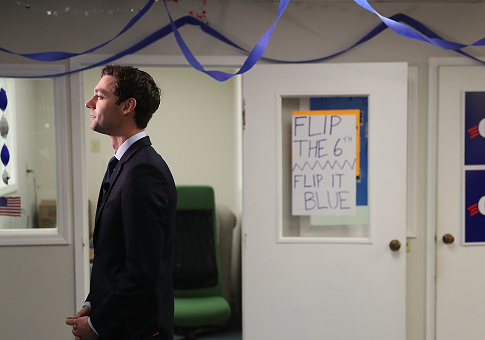An Axios analysis of political spending in special elections that found Democrats to be spending far less per vote than Republicans did not include actual campaign spending, which is how Democrats have been spending most of their money. It dramatically alters the figures presented.
The Axios analysis, which was published Wednesday morning and immediately showcased on MSNBC's Morning Joe, was presented as a "big warning for Republicans" and as evidence of a coming "wave." It found that "Democrats got more votes for their money in every competitive special election since President Trump took office."
The results were striking. In Georgia's sixth district, for example, Axios found that Republicans spent $147.01 per vote for Karen Handel, which more than doubles the $62.37 Democrats spent per vote for Jon Ossoff, the loser in the race.
The one problem in the analysis was that Axios decided not to include campaign spending, where Handel's $5.8 million in spending was five times less than the $29.2 million spent by Ossoff, which accounted for about three quarters of the money spent on his behalf.
When including campaign spending, Ossoff's figure skyrockets to $295.86 per each of the 124,893 votes he received. Handel's figure also increases to $190.31 per vote, more than $100 less than the spending per vote figure for Ossoff.
Axios makes the data used in its analysis available online and shows that campaign spending wasn't used in any of the seven races.
An updated spreadsheet with campaign spending included (added data in bold) shows the spending per vote figure for each of the seven races Axios showcased is significantly altered. The party that spent more per vote flips in three of them—Georgia's sixth district, Kansas's fourth district, and the Alabama Senate seat.
In Alabama, Democrat Doug Jones spent $19.3 million, about quadruple the $4.8 million Roy Moore spent. Including this spending brings the Jones per vote figure up to $37.97, more than four times higher than the $9.20 presented by Axios. The figure for Moore rises from $10.14 to $17.53, less than half the per vote figure for Jones.
A comparison of the figures presented by Axios and the figures including campaign spending can be viewed here.
Alexi McCammond, the author of the Axios piece, said the decision to exclude campaign spending was intentional, and that the outlet viewed it as part of an entirely different story. The figures presented in the Axios chart include only money spent by major party committees and outside groups that spent more than $250,000 on any of the given elections.
A note was added to the piece a few hours after it was published to explain that campaign spending wasn't included in the calculation. McCammond says the note was added before the Washington Free Beacon reached out to ask about the decision.
"One reason Republican groups have invested so much in these races is because Democratic candidates have out-raised their Republican challengers," the piece now says. "(Note: Candidates' own spending is not included in the numbers above.)"
It is unclear whether Axios believes money spent by campaigns has any impact on voter acquisition.
Democratic campaigns have generally outspent Republicans in each of the special elections.
In Pennsylvania's 18th district, Democrat Conor Lamb spent $4.6 million and Republican Rick Saccone spent $1.5 million. In Montana, Democrat Rob Quist spent $5.7 million and Republican Greg Gianforte spent $4.5 million.
UPDATE 5:03 p.m.: Axios says the article was updated to add the note on campaign spending not being counted after the piece was published, but before the Free Beacon reached out. This piece has been updated.
